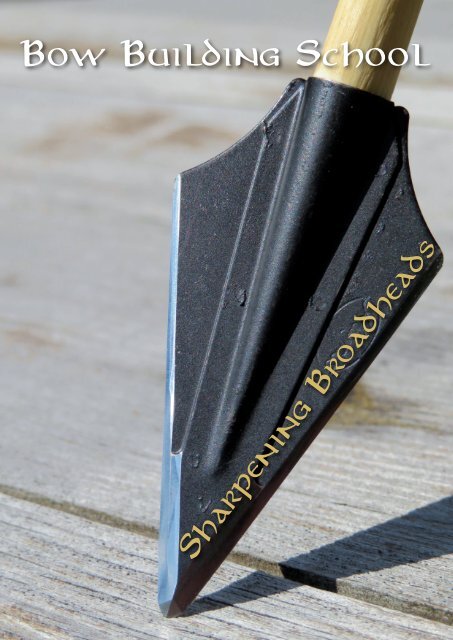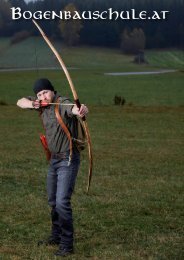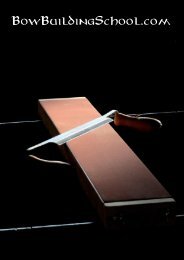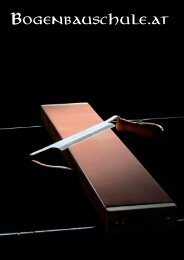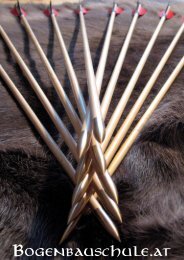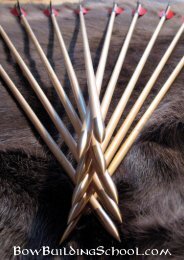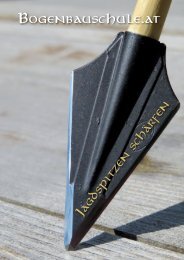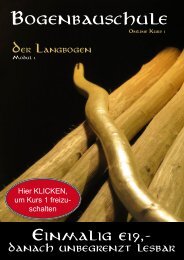Sharpening Broadheads April 2019
You also want an ePaper? Increase the reach of your titles
YUMPU automatically turns print PDFs into web optimized ePapers that Google loves.
Bow Building School<br />
<strong>Sharpening</strong> <strong>Broadheads</strong>
Imprint<br />
Publisher and owner:<br />
Matthias Wiltschko<br />
Gross Gundholz 25, 3920 Gross Gerungs, Austria<br />
www.BowBuildingSchool.com<br />
Publisher and media owner takes no legal responsibility or liability.<br />
All rights, copying, distribution and translation rights are with the<br />
owner and publisher.<br />
Text, photos, translation and layout: Matthias Wiltschko<br />
No legal responsibility or liability for injuries and damage to property<br />
of the customer/reader and third parties is taken over by the information<br />
provided and by the objects produced therefrom (eg bows,<br />
arrows . . . ). Each customer/reader is responsible for his/her own<br />
safety and safety in dealing with his/her own manufactured bows and<br />
arrows. It is at the measure of the customer/reader to judge the wood<br />
used by him/her on its resistance to breakage.
Out now in print<br />
Online Class 1<br />
346 pages - 438 color photos<br />
Worldwide Shipping<br />
$40.00 USD<br />
www.BowBuildingSchool.com
Druckversion<br />
Online Kurs 1<br />
342 seiten - 438 farbfotos<br />
Weltweiter versand<br />
Eur 36,-<br />
www.bogenbauschule.at
The angle of the cutting edge is already given for new broadheads, but<br />
they must be sharpened before they are ready for hunting.
A slowly rotating waterstone achieves the highest sharpness and cutting<br />
edge durability with relatively little effort, whether sharpening knives<br />
or broadheads. It takes me about 15 minutes to sharpen a broadhead.<br />
If you hunt with bow and arrow, you must be sure that your weapon<br />
exceeds all requirements. After the shot, there should be no thoughts<br />
like, “If only I had . . .” You must be able to trust your equipment.
At the specified angle, all blade sides are first sharpened with a grain of<br />
220 grit. Protective gloves are indispensable for double-edged blades!
The broadhead is sharpened until a burr is formed. This ensures that<br />
there is fresh metal at the cutting edge.
At exactly the same angle, the broadhead is now honed on a Japanese<br />
waterstone grit 1000. Do not change the angle and take your time.
The coarse burr is removed by the fine grinding which left a barely visible<br />
fine ridge that is still slightly connected to the cutting edge. Do not<br />
remove the fine burr!
The broadhead is now needle-pointed and would easily cut through<br />
soft tissue with this geometry. But an animal also has bones. Picture<br />
below: The light reflection shows the fine grinding ridge on the lower<br />
side of the blade.
In the next step, the razor-sharp edges are rounded at the rear end of<br />
the broadhead (grit 1000). If you use the end of your broadheads to<br />
control the draw length, you would otherwise cut your finger every time<br />
you reach full draw.
To prevent the tip from bending when bones are hit, it is formed at a<br />
duller angle on the 1000 grit waterstone.
On a leather disc at a steep angle and under the slightest pressure,<br />
the fine burr should be broken as close as possible to the cutting edge.<br />
It takes a few passes from all sides until the burr loosens everywhere.
By no means should you work your broadheads on fast-spinning grinding<br />
or polishing machines. The blade would get hot and the steel would<br />
lose its hardness and cutting edge durability.<br />
Even if you only hold the blade to a polishing disc for a short time, the<br />
cutting edge angle would be rounded off directly at the cutting edge<br />
and the blade would be dulled.<br />
But above all, the risk of injury is extremely high on such machines. If<br />
the broadhead twists easily, it could get caught by the fast-moving disc<br />
and then fly through the workshop at ludicrous speed.
On the next few pages, I‘ll show you how to sharpen your broadheads<br />
without a rotating waterstone.
From the bottom up. Mill Saw File Nr.3, Swiss Key File, Swiss Watchmaker’s<br />
File, DMT Diamond file from the USA. Place the broadhead on<br />
the surface so that the back edge sticks into the board and your index<br />
finger fixes the other side.
With minimal pressure and using the entire file length, the cutting edge<br />
is sharpened at the specified angle. The other side of the blade is<br />
sharpened against the cutting edge. Be careful not to tilt the file here<br />
and round the edge.
Now the blades are finely sharpened with a DMT Diamond File. You<br />
can also form a razor-sharp rounded tip. More complicated, but foremost<br />
slower, is the technique with the waterstone. Leave the stone in<br />
the water until it is soaked and you see no more air bubbles.
At the given angle, the broadhead is sharpened with smooth forward<br />
and backward movements. You can also sharpen your broadheads by<br />
sticking sandpaper on a picture frame. This way you get a flat sanding<br />
surface. Try out what suits you best.
Video - <strong>Sharpening</strong> <strong>Broadheads</strong>


